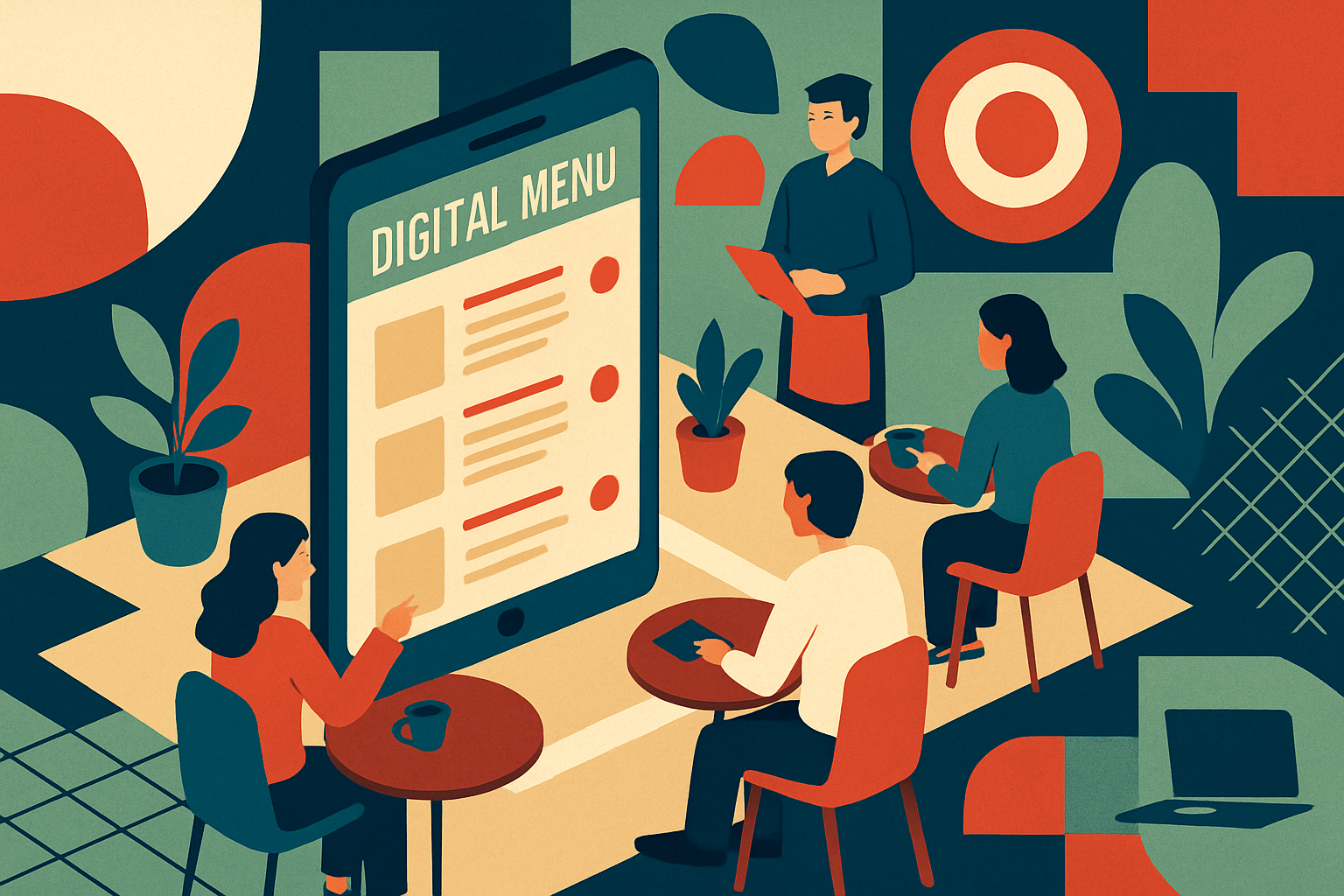
Transform Your Menu into a Digital Experience
Transform Your Menu into a Digital Experience
Elevate your restaurant’s brand and customer satisfaction through cutting-edge digital menus.
The Importance of Moving to a Digital Menu
In today’s fast-paced dining environment, transforming your menu into a digital experience is no longer optional. It is a critical step for restaurants that want to enhance customer engagement, streamline operations, and stay competitive.
A well-designed digital menu goes far beyond simply replacing paper. It empowers customers to explore menu items interactively, view detailed descriptions, filter by dietary preferences, and even see photos or videos that influence ordering decisions. This interactivity supports better decision-making and increases average order value by making the menu experience both informative and enticing.
Digital menus also send a clear message: your restaurant embraces innovation. Consumers increasingly expect technology to be part of their dining journey—from mobile ordering to contactless payment. By adopting digital menus, restaurants demonstrate they are in tune with modern preferences, building trust and loyalty among tech-savvy diners.
On the operational side, digital menus cut down on printing costs and make it easy to update items in real time. Whether adjusting prices, promoting seasonal specials, or highlighting sold-out items, staff can instantly push updates without reprinting or re-explaining to each guest. This saves time, reduces errors, and keeps the dining experience consistent.
Ultimately, adopting digital menus is about more than convenience. It is about positioning your restaurant as forward-thinking and customer-focused. In a competitive food industry, this shift can be the difference between simply surviving and truly thriving.
Benefits of a Digital Menu
1. Enhanced Customer Engagement
A digital menu transforms the dining experience from static to interactive. Instead of scanning text-heavy lists, guests can browse rich visuals, view ingredient details, and discover curated pairings or chef’s notes. These features make the menu more than a list—it becomes part of the storytelling behind each dish. The result is deeper customer engagement, increased curiosity, and often, higher check averages.
2. Real-Time Flexibility
Unlike printed menus that quickly become outdated, digital menus allow restaurants to make immediate adjustments. Prices, specials, and limited-time offers can be updated on the spot, and out-of-stock items can be removed instantly to avoid customer disappointment. This agility keeps the dining experience smooth while reducing staff stress and operational bottlenecks.
3. Inclusive Dining Options
Today’s diners expect restaurants to recognize diverse dietary needs, from vegan and gluten-free to allergy-conscious options. A digital menu makes it easy to add dietary filters, highlight allergen information, and showcase substitutions. This inclusivity not only boosts customer satisfaction but also builds trust by showing guests that their needs are valued and respected.
4. Seasonal and Promotional Adaptability
Restaurants thrive on variety—rotating seasonal dishes, experimenting with new flavors, and running promotional campaigns. A digital menu provides the flexibility to highlight these changes seamlessly, ensuring customers are always presented with the freshest and most relevant offerings.
5. Actionable Insights through Analytics
Beyond the customer-facing experience, digital menus provide a powerful back-end advantage. Analytics can track which items are most viewed, where customers hesitate, and what drives conversions. These insights help restaurants identify star performers, refine underperforming items, and make data-driven decisions about pricing, portioning, and promotions. Over time, this creates a smarter, more profitable menu strategy.
6. Cost and Sustainability Advantages
By reducing or eliminating the need for reprinting, digital menus save money and lower waste. This shift aligns with sustainability goals, appealing to eco-conscious diners who increasingly prefer businesses that adopt greener practices.
Examples of Successful Digital Menu Implementations
Consider a popular pizzeria, “Slice of Heaven”. They revamped their menu to an interactive online format where customers could customize pizzas in real-time. This not only improved customer satisfaction but also increased upselling opportunities.
Another success story is “Bistro Delight”, which introduced QR code menus. Customers could easily access the menu via their smartphones, enabling contactless ordering and efficient service. This approach increased order accuracy and significantly reduced wait times.
Implementation Steps for Your Digital Menu Transformation
To successfully transition to a digital menu, follow this step-by-step workflow:
- Evaluate Your Current Menu: Assess what items resonate with your audience, and think about how they can be showcased digitally.
- Choose the Right Platform: Research digital menu platforms that align with your restaurant’s needs, allowing easy updates and customer interaction.
- Design for Engagement: Focus on user-friendly design with appealing visuals that enhance the food experience.
- Incorporate Features: Add features such as real-time updating, dietary options, and customer reviews to boost engagement.
- Launch and Promote: Introduce your digital menu with a marketing campaign to raise awareness, encouraging customers to explore the new offerings.
Possible Digital Menu Platform Solutions
- Square Online (Square for Restaurants)
Lets restaurants build an online ordering site that syncs directly with their POS system. Supports pickup, delivery, and QR code menus. - Toast Online Ordering
Integrated with Toast’s POS system, it allows restaurants to create digital menus for web and mobile ordering. Offers contactless ordering, delivery, and loyalty features. - ChowNow
Provides branded online ordering for restaurants, commission-free. Customers can order through the restaurant’s website, mobile app, or Google/Facebook integrations. - Upserve (by Lightspeed)
Offers online ordering tied to a restaurant’s POS. Includes menu management, customer insights, and marketing features. - GloriaFood
A free online ordering system where restaurants can publish digital menus, accept orders via website or app, and manage delivery or pickup.
Setting Measurable KPIs and Diagnostics
1. Core Performance Metrics
- Customer Engagement Rates: Track how often diners interact with specific features such as item filters, nutritional details, or promotional banners. High engagement signals that the digital menu is effectively capturing attention.
- Order Accuracy: Monitor error reduction in orders placed through the digital menu compared to traditional methods. A decline in mistakes directly translates into improved customer satisfaction and lower food waste.
- Sales Growth and Average Order Value (AOV): Identify whether the digital menu increases upsells or cross-sells by showcasing add-ons, combos, or premium items. This metric connects directly to profitability.
2. Operational Efficiency Metrics
- Update Speed: Measure the time it takes to push out changes—such as marking an item out of stock or adding a seasonal special. Faster updates prevent service disruptions and keep the customer experience seamless.
- Staff Productivity: Evaluate whether staff spend less time explaining menu details or correcting orders, allowing them to focus more on service quality.
3. Customer Feedback and Experience
Data alone doesn’t capture the full picture. Collecting consistent feedback from guests ensures you understand how diners perceive the digital menu. Effective approaches include:
- Post-Dining Surveys: Quick, mobile-friendly questionnaires that ask about ease of use, clarity, and overall satisfaction.
- Prompt-Based Feedback: Simple prompts integrated into the digital experience, such as “Was this menu easy to use?” with one-click responses.
- Qualitative Insights: Encourage open-ended comments to capture ideas, frustrations, or suggestions directly from customers.
4. Long-Term Diagnostics
Beyond short-term results, diagnostics should evaluate whether the digital menu is contributing to broader restaurant goals:
- Customer Retention and Loyalty: Track whether guests return more frequently after digital menus are introduced.
- Brand Perception: Assess whether customers see your restaurant as modern, innovative, and responsive to their needs.
- Sustainability Impact: Monitor reductions in paper waste and printing costs, aligning with eco-conscious goals.
Grow Your Restaurant
Stop guessing. Start Growing.
I help restaurants like yours build a standout brand, automate marketing, and fill tables. Learn more…
Common Pitfalls to Avoid
While transitioning to a digital menu is exciting, it can come with challenges. A common pitfall is overwhelming customers with excessive features. Simplifying navigation will enhance user experience, avoiding confusion.
Another pitfall is neglecting to update the menu frequently. Stale content can frustrate customers and diminish the perceived quality of your restaurant. Regularly refresh your menu to reflect changing options and customer preferences.
Myth-Busting the Digital Menu Dilemma
Many believe that implementing a digital menu is too complex and costly for small restaurants. However, numerous affordable platforms cater to smaller businesses, providing easy-to-use solutions that require minimal technical knowledge.
Next Steps for Transforming Your Menu into a Digital Experience
Start your digital menu transformation to create an innovative restaurant environment. By enhancing customer engagement through an interactive menu experience, you’ll not only increase satisfaction but potentially boost sales through upselling opportunities and better decision-making.
Are you ready to elevate your restaurant’s brand? Don’t hesitate to take the first step towards a more engaging food experience today!


